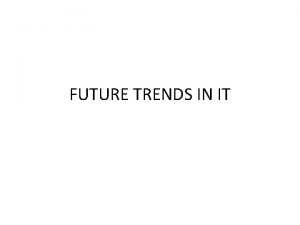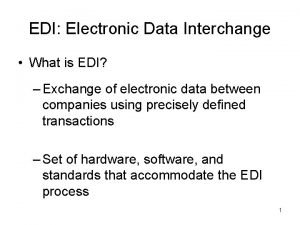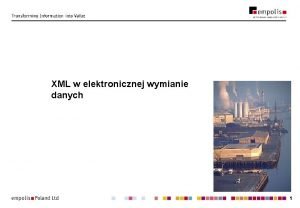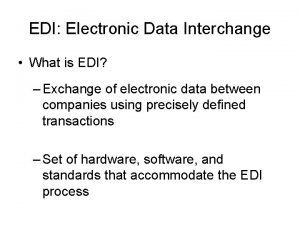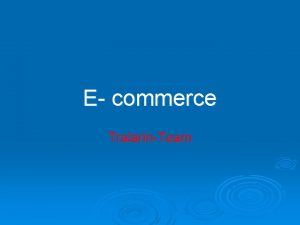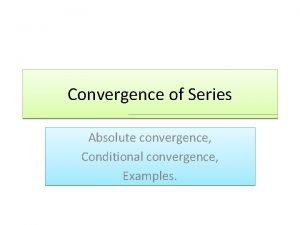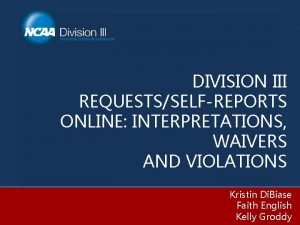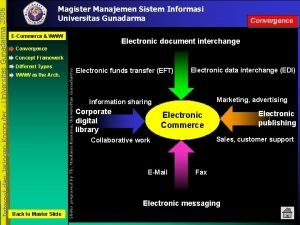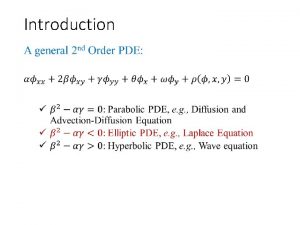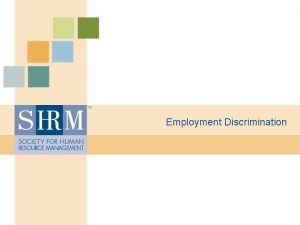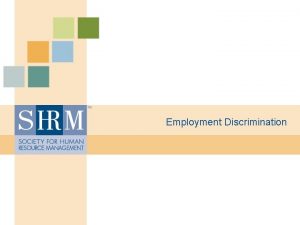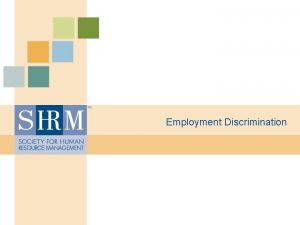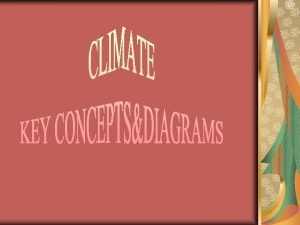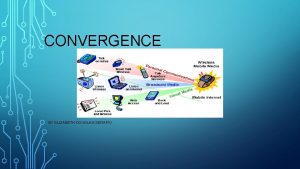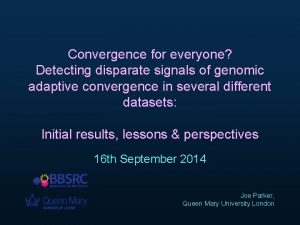Convergence of Previously Disparate Functions Electronic Document Interchange












- Slides: 12

Convergence of Previously Disparate Functions Electronic Document Interchange Electronic funds transfer (EFT) Corporate digital library Information Sharing Collaborative work Electronic data interchange (EDI) Electronic Commerce E-mail Marketing, advertising Sales, customer support Fax Electronic messaging Electronic publishing

Attributes of Electronic Commerce Business/Retail Business Models Storefront E-catalog Computer telephone integration Interactive TV Bulletin board system Automatic teller machine Kiosks Business/Industrial Request for quote procurement models of the Electronic Commerce Acquisition Program Management Office(ECAPMO) Electronic tax filing Economic census Reporting Data Encryption Standard (DES) RSA Triple DES RSA Key escrow X 12. 58 Just-in-time (JIT) ordering Evaluated Receipt settlement(ERS) Reference model for health care Automatic replenishment Efficient Customer Response(ECR) Privacy Enhanced Mail Secure Hyper. Text Transport Protocol(S-HTTP) Electronic stamps Secure Socket Layer(SSL) Secure Electronic Transaction (SET) Internet Communication Cable Infrastructure Service bureau Value-added networks Security Data Management Government Wide Area Information Server (WAIS) Hyper. Text Markup Language (HTML) Info access to graphics, video, audio, and text Value-added networks Value-added banks Internet Direct connections EDIFACT ANSI ASC X 12 UPC/EAN Industry guides Info access to text Value-added networks Value-added banks Internet NIST ECAT Implementation Convention (C) Info access to text

Scope of Electronic Commerce On-line databases Computeraided collaboration On-line Computer conferencing and bulletin boards Workflow E-mail EDI EFT Computer-to-computer automated exchanges Computer-aided people-to people Store and forward

Changes and Drivers of EC Business • Global competition • Disregulation/regulation • Competition from new and nontraditional players • Blurring of industry lines Societal • Demand for convenience personalization, quality and value • Global interactions • Technology’s proliferation into consumer markets Marketing • Fragmentation of markets • Declining effectiveness of mass media • New marketing and dist. channels/interactive media Technology • Microprocessor price/perf. • Open system & client/server • Increasing volumes of data • Internet • Data warehousing, MPP, OLAP

Electronic Marketplace Extends Reach Electronic Marketplace Traditional EC Small and Medium Size Businesses Consumers ISPs Commercial Partners Certif. Auth. Banks VANs OLSs ISPs Credit Cards E-Cash OLSs Internal Systems and Processes External Network Interfaces/Security Interfaces Purchasing Invoice Ordering Payment Sales & Mktg. External Systems and Processes Messaging Customer Support Human Resources

Electronic Commerce Architecture Web Server Functions Third-Party Services Local or Company-Specific Data Information Retrieval Digital Library of Document/Data Servers Web Browser Data and Transaction Management Third-Party Information Processing Tools/Services Browser Extensions Secure Messaging Client Browser Electronic Payment Servers

Different Types of Electronic Payment Systems Payment Type Open exchange Secured linkage or presentation Trusted third party Digital check Digital cash Description The most widely used payment method today. Credit card information is provided to a merchant via E-mail or Web page response without encryption or protection. Encrypted transmission of information between buyers and sellers over the Internet providing authentication by means of common software ( such as securityenhanced Web browsers. A trusted intermediary service that provides credibility for both buyer and seller, manages Internet-based transaction accounts, and either provides for the transfer of funds between accounts or for the authentication of the transaction with banks or credit card clearing facilities. A network-based replacement for the paper check that uses existing inter-bank clearing systems. The use of digital tokens that represent secure currency (without double spending) and allow direct buyer-to-seller transfer of value.

Web Payment Solutions Credit-based IBM Info. Market Clickshare Net. Bill Visa Master. Card First Virtual Cyber. Cash credit card Check. Free credit card FSTC Electronic Check Netcheque Cyber. Cash Check Debit-based Cyber. Cash Cybercoins Digital currency Digi. Cash Net. Cash <$5 Citibank Transaction Value >$50

Electronic Commerce Standards Area Internet and the World Wide Web Value-Added Networks HTML, HTTP, CGI, TCP/IP, FTP, SMTP, MIME, SSL, SGML, URL Electronic Data Interchange (EDI) Image Data ANSI X 12, UN/EDIFACT Financial Payments Security Asynch, Bisynch, X. 25, SNA, APPN, X. 400, X. 435 GIF, JPEG ANSI X 12. 4 - #820, NACHA’s CCD+, CTX, SET, JEPI RSA, DES

Internet Standards and Protocols for Electronic Commerce Name Description Organization Formal Standards and Protocols TCP/IP Underlying network transport protocols SGML Markup language for text manipulation IETF HTML ISO, W 3 C, SGML Open SGML application for hypertext manipulation; language most Web. W 3 C, SGML Open pages use HTTP Protocol for transferring hypertext documents on the Web W 3 C URL Enables information addressing on the Web W 3 C FTP MIME File Transfer Protocol for information exchange IETF Multimedia E-mail standard and a building block for HTTP IETF SSL IETF SMTP Security Sockets Layer that allows for more secure communications; also a product from Netscape Core Internet protocol for sending and receiving E-mail CGI Common Gateway Interface W 3 C IETF

Internet Standards and Protocols for Electronic Commerce Name Description Organization Vendor De Facto Standards NSAPI Netscape Server API Java Programming language and environment for the Web Active. X Microsoft products that enhance Internet Web pages, such as allowing for the inclusion of moving objects SET Secure Electronic Transaction Standard Netscape Sun Microsoft Master. Card and Visa

Key Electronic Commerce Infrastructure Providers Sector Vendors Electronic Market Managers AT&T Corp. , Compu. Serve, GEIS, IBM, MCI, Communications Platform/Service Providers Digital Equipment Corp. , HP, IBM, Silicon, Graphics, Sun Server/Software Developers Broad. Vision Inc. , Microsoft, Netscape, Open Market, Spyglass Inc. Component Providers Check. Free, Cyber. Cash, Digital, First Virtual Holdings Inc. , Harbinger Corp. , Master. Card, Premenos, Sterling Commerce Inc. , Visa
 Future of electronic data interchange
Future of electronic data interchange Advantages webedi
Advantages webedi Eb xml
Eb xml Define edi in e commerce
Define edi in e commerce Define edi in e commerce
Define edi in e commerce If the absolute value of a series converges
If the absolute value of a series converges Que disparate se mato un tomate
Que disparate se mato un tomate Disparate treatment
Disparate treatment Is the electronic exchange of money or scrip
Is the electronic exchange of money or scrip Electronic news gathering and electronic field production
Electronic news gathering and electronic field production Archaebacteria facts
Archaebacteria facts What thailand was previously known as
What thailand was previously known as Ncaa previously approved waivers
Ncaa previously approved waivers
